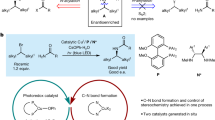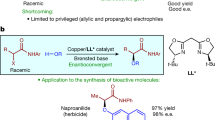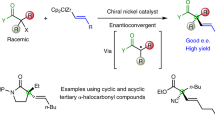Abstract
In view of the high propensity of tertiary alkyl amines to be bioactive, the development of new methods for their synthesis is an important challenge. Transition-metal catalysis has the potential to greatly expand the scope of nucleophilic substitution reactions of alkyl electrophiles; unfortunately, in the case of alkyl amines as nucleophiles, only one success has been described so far: the selective mono-alkylation of primary amines to form secondary amines. Here, using photoinduced copper catalysis, we report the synthesis of tertiary alkyl amines from secondary amines and unactivated alkyl electrophiles, two readily available coupling partners. Utilizing an array of tools, we have analysed the mechanism of this process; specifically, we have structurally characterized the three principal copper-based intermediates that are detected during catalysis and provided support for the key steps of the proposed catalytic cycle, including the coupling of a copper(II)–amine intermediate with an alkyl radical to form a C–N bond.

This is a preview of subscription content, access via your institution
Access options
Access Nature and 54 other Nature Portfolio journals
Get Nature+, our best-value online-access subscription
27,99 € / 30 days
cancel any time
Subscribe to this journal
Receive 12 print issues and online access
269,00 € per year
only 22,42 € per issue
Buy this article
- Purchase on SpringerLink
- Instant access to full article PDF
Prices may be subject to local taxes which are calculated during checkout



Similar content being viewed by others
Data availability
The data that support the findings of this study are available within the Article and its Supplementary Information (experimental procedures and characterization data). Crystallographic data for the structures reported in this Article have been deposited at the Cambridge Crystallographic Data Centre, under deposition numbers CCDC 2346103 (20), 2346099 (23), 2346098 (26), 2346097 (28), 2346096 (34), 2346086 (A, PCuI(OPh)), 2346089 (G, PCuI(MSA), 2346084 ([(MSA)CuII(OPh)]4), 2346093(H, [(MSA)(HR2N)CuII(μ-OPh)]2), 2346085 (E1, (MSA)CuII(OAr1)(NR2H)2), 2346102 ([(MSA)CuII(OAr1)]2), 2346100 ((MSA)2CuII(NR2H)), 2346094 ((MSA)2CuII(NR12H)) and 2346095 ((MSA)2CuII(NR12H)2). Copies of the data can be obtained free of charge via https://www.ccdc.cam.ac.uk/structures/ (or from Cambridge Crystallographic Data Centre, 12 Union Road, Cambridge, CB2 1EZ, United Kingdom; fax: +44-1223-336-033; email: [email protected]).
References
Manallack, D. T. et al. A chemogenomic analysis of ionization constants—implications for drug discovery. ChemMedChem 8, 242–255 (2013).
Knölker, H.-J. The Alkaloids Vol. 90 (Elsevier, 2023).
Funayama, S. & Cordell, G. A. Alkaloids: A Treasury of Poisons and Medicines (Academic Press, 2014).
Sodano, T. M., Combee, L. A. & Stephenson, C. R. J. Recent advances and outlook for the isosteric replacement of anilines. ACS Med. Chem. Lett. 11, 1785–1788 (2020).
Mykhailiuk, P. K. Saturated bioisosteres of benzene: where to go next? Org. Biomol. Chem. 17, 2839–2849 (2019).
Subbaiah, M. A. M. & Meanwell, N. A. Bioisosteres of the phenyl ring: recent strategic applications in lead optimization and drug design. J. Med. Chem. 64, 14046–14128 (2021).
Neumann, H.-G. Aromatic amines: mechanisms of carcinogenesis and implications for risk assessment. Front. Biosci. 15, 1119–1130 (2010).
Ricci, A. & Bernardi, L. Methodologies in Amine Synthesis: Challenges and Applications (Wiley, 2021).
Marvin, C. C. in Comprehensive Organic Synthesis (eds Knochel, P. & Molander, G. A.) Vol. 6.02, 34–99 (Elsevier, 2014).
Afanasyev, O. I., Kuchuk, E., Usanov, D. L. & Chusov, D. Reductive amination in the synthesis of pharmaceuticals. Chem. Rev. 119, 11857–11911 (2019).
Shi, F. & Cui, X. Catalytic Amination for N-Alkyl Amine Synthesis (Academic Press, 2018).
Trowbridge, A., Walton, S. M. & Gaunt, M. J. New strategies for the transition-metal catalyzed synthesis of alkyl amines. Chem. Rev. 120, 2613–2692 (2020).
Kumar, R., Flodén, N. J., Whitehurst, W. G. & Gaunt, M. J. A general carbonyl alkylative amination for tertiary amine synthesis. Nature 581, 415–420 (2020).
Brown, D. G. & Böstrom, J. Analysis of past and present synthetic methodologies on medicinal chemistry: where have all the new reactions gone? J. Med. Chem. 59, 4443–4458 (2016).
Górski, B., Barthelemy, A.-L., Douglas, J. J., Juliá, F. & Leonori, D. Copper-catalysed amination of alkyl iodides enabled by halogen-atom transfer. Nat. Catal. 4, 623–630 (2021).
Fu, G. C. Transition-metal catalysis of nucleophilic substitution reactions: a radical alternative to SN1 and SN2 processes. ACS Cent. Sci. 3, 692–700 (2017).
Bissember, A. C., Lundgren, R. J., Creutz, S. E., Peters, J. C. & Fu, G. C. Transition-metal-catalyzed alkylations of amines with alkyl halides: photoinduced, copper-catalyzed couplings of carbazoles. Angew. Chem. Int. Ed. 52, 5129–5133 (2013).
Do, H.-Q., Bachman, S., Bissember, A. C., Peters, J. C. & Fu, G. C. Photoinduced, copper-catalyzed alkylation of amides with unactivated secondary alkyl halides at room temperature. J. Am. Chem. Soc. 136, 2162–2167 (2014).
Peacock, D. M., Roos, C. B. & Hartwig, J. F. Palladium-catalyzed cross coupling of secondary and tertiary alkyl bromides with a nitrogen nucleophile. ACS Cent. Sci. 2, 647–652 (2016).
Ahn, J. M., Peters, J. C. & Fu, G. C. Design of a photoredox catalyst that enables the direct synthesis of carbamate-protected primary amines via photoinduced, copper-catalyzed N-alkylation reactions of unactivated secondary halides. J. Am. Chem. Soc. 139, 18101–18106 (2017).
Chen, C., Peters, J. C. & Fu, G. C. Photoinduced copper-catalysed asymmetric amidation via ligand cooperativity. Nature 596, 250–256 (2021).
Dow, N. W., Cabré, A. & MacMillan, D. W. C. A general N-alkylation platform via copper metallaphotoredox and silyl radical activation of alkyl halides. Chem 7, 1827–1842 (2021).
Matier, C. D., Schwaben, J., Peters, J. C. & Fu, G. C. Copper-catalyzed alkylation of alkyl amines induced by visible light. J. Am. Chem. Soc. 139, 17707–17710 (2017).
Abdel-Magid, A. F. & Mehrman, S. J. A review on the use of sodium triacetoxyborohydride in the reductive amination of ketones and aldehydes. Org. Process Res. Dev. 10, 971–1031 (2006).
Hutchins, R. O., Su, W.-Y., Sivakumar, R., Cistone, F. & Stercho, Y. P. Stereoselective reductions of substituted cyclohexyl and cyclopentyl carbon–nitrogen π systems with hydride reagents. J. Org. Chem. 48, 3412–3422 (1983).
Gilbert, S. H., Tin, S., Fuentes, J. A., Fanjul, T. & Clarke, M. L. Rhodium catalysts derived from a fluorinated phanephos ligand are highly active catalysts for direct asymmetric reductive amination of secondary amines. Tetrahedron 80, 131863 (2021).
Nandhu, C. T., Aneeja, T. & Anilkumar, G. Advances and perspectives in the rhodium catalyzed reductive amination reactions. J. Organomet. Chem. 965–966, 122332 (2022).
Gilbert, S. H., Viseur, V. & Clarke, M. L. A consecutive process for C–C and C–N bond formation with high enantio- and diastereo-control: direct reductive amination of chiral ketones using hydrogenation catalysts. Chem. Commun. 55, 6409–6412 (2019).
Gianatassio, R. et al. Strain-release amination. Science 351, 241–246 (2016).
Hughes, J. M. E., Scarlata, D. A., Chen, A. C.-Y., Burch, J. D. & Gleason, J. L. Aminoalkylation of [1.1.1]propellane enables direct access to high-value 3-alkylbicyclo[1.1.1]pentan-1-amines. Org. Lett. 21, 6800–6804 (2019).
Bergamaschi, E. & Teskey, C. Bioisosteres of meta-substituted benzenes. Nachr. Chem. 71, 68–71 (2023).
Frank, N. et al. Synthesis of meta-substituted arene bioisosteres from [3.1.1] propellane. Nature 611, 721–726 (2022).
Yu, Z. & Shi, L. Synthetic routes to bicyclo[1.1.1]pentylamines: booming toolkits for drug design. Org. Chem. Front. 9, 3591–3597 (2022).
Nomura, M. et al. Discovery of cyclic amine-substituted benzoic acids as PPARα agonists. Bioorg. Med. Chem. Lett. 22, 334–338 (2012).
Duong, L. T., Leung, A. T. & Langdahl, B. Cathepsin K inhibition: a new mechanism for the treatment of osteoporosis. Calcif. Tissue Int. 98, 381–397 (2016).
Zhang, X. et al. Copper-mediated synthesis of drug-like bicyclopentanes. Nature 580, 220–226 (2020).
Saveant, J.-M. Dissociative electron transfer. New tests of the theory in the electrochemical and homogeneous reduction of alkyl halides. J. Am. Chem. Soc. 114, 10595–10602 (1992).
Cho, H., Suematsu, H., Oyala, P. H., Peters, J. C. & Fu, G. C. Photoinduced, copper-catalyzed enantioconvergent alkylations of anilines by racemic tertiary electrophiles: synthesis and mechanism. J. Am. Chem. Soc. 144, 4550–4558 (2022).
Lin, S., Peng, Q., Ou, Q. & Shuai, Z. Strong solid-state fluorescence induced by restriction of the coordinate bond bending in two-coordinate copper(I)–carbene complexes. Inorg. Chem. 58, 14403–14409 (2019).
Demarteau, J., Debuigne, A. & Detrembleur, C. Organocobalt complexes as sources of carbon-centered radicals for organic and polymer chemistries. Chem. Rev. 119, 6906–6955 (2019).
Branchaud, B. P., Meier, M. S. & Choi, Y. Alkyl-alkenyl cross coupling via alkyl cobaloxime radical chemistry. An alkyl equivalent to the Heck reaction compatible with common organic functional groups. Tetrahedron Lett. 29, 167–170 (1988).
Pearson, R. G. Hard and soft acids and bases—the evolution of a chemical concept. Coord. Chem. Rev. 100, 403–425 (1990).
Clark, K. F., Dimitrova, D. & Murphy, J. A. in Science of Synthesis, Free Radicals: Fundamentals and Applications in Organic Synthesis 2 (eds Fensterbank, L. & Ollivier, C.) 1–82 (Thieme, 2021).
Chan, A. Y. et al. Metallaphotoredox: the merger of photoredox and transition metal catalysis. Chem. Rev. 122, 1485–1542 (2022).
Acknowledgements
Support has been provided by the National Institutes of Health (National Institute of General Medical Sciences: R35–GM145315, Fu group), the Korea Foundation for Advanced Studies (graduate research fellowship to H.C.), the Swiss National Science Foundation (grant P2SKP2_191321 to G.Z.), the Beckman Institute at Caltech, the Dow Next-Generation Educator Fund (grant to Caltech) and Takasago International Corporation. We thank J. C. Peters, R. G. Hadt, P. H. Oyala (EPR Facility), M. K. Takase (X-ray Crystallography Facility), D. VanderVelde (NMR Facility), S. C. Virgil (Center for Catalysis and Chemical Synthesis), J. R. Winkler (Laser Resource Center), W. W. Brennessel (Mass Spectrometry Resource Laboratory), C. Chen, F. Schneck, S. Alabugin, D. A. Cagan, P. Garrido Barros, V. Hubble, C. M. Johansen, A. N. Kim, L. N. V. Le and M. Li for technical assistance and helpful discussions.
Author information
Authors and Affiliations
Contributions
H.C. discovered and optimized the reaction, investigated its scope and performed mechanistic studies. X.T. investigated the scope of the reaction and optimized the three-component coupling. G.Z. investigated the scope of the reaction. R.L.A. performed density functional theory (DFT) calculations. All authors actively participated in writing the manuscript and contributed to the analysis and interpretation of the results.
Corresponding author
Ethics declarations
Competing interests
The authors declare no competing interests.
Peer review
Peer review information
Nature Chemistry thanks the anonymous reviewers for their contribution to the peer review of this work.
Additional information
Publisher’s note Springer Nature remains neutral with regard to jurisdictional claims in published maps and institutional affiliations.
Supplementary information
Supplementary Information
Supplementary Figs. 1–28 and Tables 1–9.
Supplementary Data 1
Cartesian coordinates of calculated structures.
Supplementary Data 2
Crystallographic data for compound 20; CCDC reference 2346103.
Supplementary Data 3
Crystallographic data for compound 23; CCDC reference 2346099.
Supplementary Data 4
Crystallographic data for compound 26; CCDC reference 2346098.
Supplementary Data 5
Crystallographic data for compound 28; CCDC reference 2346097.
Supplementary Data 6
Crystallographic data for compound 34; CCDC reference 2346096.
Supplementary Data 7
Crystallographic data for compound A, PCuI(OPh); CCDC reference 2346086.
Supplementary Data 8
Crystallographic data for compound G, PCuI(MSA); CCDC reference 2346089.
Supplementary Data 9
Crystallographic data for compound [(MSA)CuII(OPh)]4; CCDC reference 2346084.
Supplementary Data 10
Crystallographic data for compound H, [(MSA)(HR2N)CuII(μ-OPh)]2; CCDC reference 2346093.
Supplementary Data 11
Crystallographic data for compound E1, (MSA)CuII(OAr1)(NR2H)2; CCDC reference 2346085.
Supplementary Data 12
Crystallographic data for compound [(MSA)CuII(OAr1)]2; CCDC reference 2346102.
Supplementary Data 13
Crystallographic data for compound (MSA)2CuII(NR2H); CCDC reference 2346100.
Supplementary Data 14
A CIF file for compound (MSA)2CuII(NR12H); CCDC reference 2346094.
Supplementary Data 15
A CIF file for compound (MSA)2CuII(NR12H)2; CCDC reference 2346095.
Rights and permissions
Springer Nature or its licensor (e.g. a society or other partner) holds exclusive rights to this article under a publishing agreement with the author(s) or other rightsholder(s); author self-archiving of the accepted manuscript version of this article is solely governed by the terms of such publishing agreement and applicable law.
About this article
Cite this article
Cho, H., Tong, X., Zuccarello, G. et al. Synthesis of tertiary alkyl amines via photoinduced copper-catalysed nucleophilic substitution. Nat. Chem. 17, 271–278 (2025). https://doi.org/10.1038/s41557-024-01692-w
Received:
Accepted:
Published:
Issue Date:
DOI: https://doi.org/10.1038/s41557-024-01692-w



